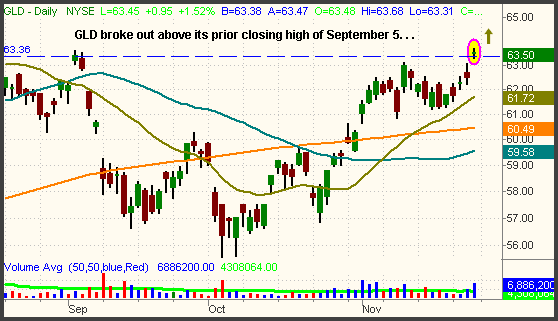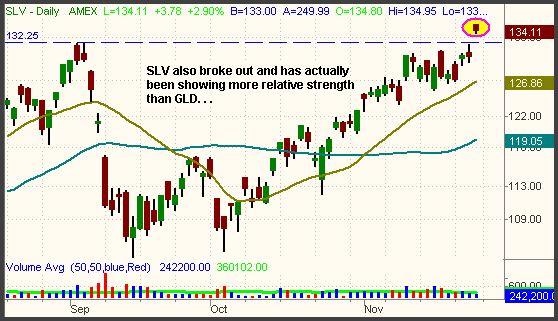The stock market began last Friday's post-holiday session with a large opening gap down, but recovered a portion of those losses later in the morning before closing at 1:00 pm EST. The Nasdaq Composite again exhibited relative strength by closing only 0.2% lower compared to the 0.4% loss in the S&P 500. Intraday action also confirmed the price divergence, as the Nasdaq briefly recovered into positive territory two hours after the open, but the S&P showed a loss throughout the entire day. Like the S&P 500, the Dow Jones Industrial Average also fell 0.4%, but both the small-cap Russell 2000 and S&P Midcap 400 indices gave up only 0.1%.
With the stock market concluding three hours early, turnover obviously declined sharply in both exchanges. In the NYSE, total volume was 61% lower than the previous day's level. Volume in the Nasdaq declined by 58%. Adjusted for the early closing time, volume in the NYSE was still 36% lighter than the previous day at 1:00 pm EST. The Nasdaq volume was on pace to be 29% lower. The minimal number of shares that traded hands means that Friday's price action was not confirmed due to the absence of institutional trading activity. Beneath the surface, however, market internals were negative. In the Nasdaq, declining volume exceeded advancing volume by a margin of 2 to 1. The ratio in the NYSE was negative by 1.2 to 1.
Not surprisingly, most industry sectors closed within 1% of unchanged in Friday's shortened session. But to our satisfaction, gold was the one exception. A $10 per ounce overnight jump in the price of the spot gold commodity caused our long position in the StreetTRACKS Gold Trust (GLD) to correspondingly rally 1.6% and finish at its highest level since August 9. Individual gold mining stocks performed even better than spot gold, as the CBOE Gold Index ($GOX) zoomed 2.6% higher. In the November 22 issue of The Wagner Daily, we illustrated a weekly chart of GLD and mentioned that we soon expect a breakout above the three-week range. This breakout came on Friday, as you can see on the daily chart below:

Since our initial entry one month ago, GLD is showing an unrealized gain of more than 8%, but we remain long because the ETF has not yet given us a good reason to sell. Many new traders mistakenly think that a high percentage of accuracy on your stock or ETF picks is necessary in order to be consistently profitable, but this is not true. On average, we make a profit on only about 40 - 50% of our trades, BUT the dollar gain of our average winner is usually close to double the loss of the average loser. While simple math dictates that such statistics will result in a long-term winning strategy, the key point is that net profitability can only occur from maximizing profits on the winners and being disciplined with stop losses on the losers. Though we set price targets on our trades, they are only to be used as a guideline. If a position is acting very well, we will sometimes raise our target because there is no reason to sell. However, we always trail an increasingly tightening stop in order to protect profits just in case the stock or ETF surprises us. With GLD, our new price target is just below resistance of the August 2006 high of 65.22. We plan to sell into strength as GLD approaches that level because it is a logical resistance level at which it will likely take a break and at least correct by time before moving much higher.
Spot silver has been showing even more relative strength than gold, and don't forget that the iShares Silver Trust (SLV) is a great way to participate in a corresponding move in the silver commodity. Check out last Friday's breakout:

In addition to its bullish technical pattern, major weakness in the U.S. dollar is one reason gold has been doing well. As you may recall, we began following the bullish chart pattern in the CurrencyShares Euro Trust (FXE) just before it broke out on November 22. That day, FXE gained 0.8%, then followed up the move with another 1.1% gain on November 24. Unfortunately, it has been difficult to directly profit from the breakout because both days' gains have been the result of large opening gaps, not intraday strength. Because we have clearly defined rules regarding opening gaps, the MTG Opening Gap Rules, the only way we could have profited from the FXE strength is to have bought the consolidation before it actually broke out. But buying consolidations without waiting for confirmation of the breakout carries a much higher risk. Regardless, the strength in FXE has been impressive and we like the idea of buying the first pullback to near support of the breakout level. As the weekly chart below illustrates, a pullback to just below the $130 level would provide an ideal entry point if not already long:

In addition to gold, we are watching for a potential breakout above the sideways range of the Semiconductor Index ($SOX). Since rallying above its 200-day MA and weekly downtrend line on November 14, the $SOX has been consolidating in a narrow range that may serve as a base from which to make another leg up. However, the only thing that makes us a little bit reluctant to aggressively buy a $SOX breakout is that the major indices remain extended pretty far away from support of the lower channels of their uptrend lines. Even though the $SOX looks good, the sector may be out of sync with the broad market because its rally came in the late stages of the broad market's rally. If the market begins to correct, the $SOX may have a tough time holding up. Nevertheless, there's no major risk in buying a breakout in the Semiconductor HOLDR (SMH), the iShares Semiconductor (IGW), or any of the others, but you might consider reducing your position size and keeping a tighter than usual stop in order to minimize your risk in the event of a failed breakout.
Finally, be on the lookout for a breakout in crude oil and/or the various oil-related ETFs. We recently pointed out the bullish setup in the Oil Service HOLDR (OIH), and we continue to feel it will break out sometime within the next few days. We already bought OIH when it crossed above its 200-day MA last Friday, but it drifted lower into the close. Still, it finished near the pivot on its fifth attempt to close above the 200-day MA, so it should go soon. If interested in an ETF that loosely mirrors the price of the actual crude oil commodity, the U.S. Oil Fund (USO) is the one to watch, but it's still glued to its low and therefore carries higher risk of a bottom not yet being firmly established.
Deron Wagner is the Founder and Head Trader of both Morpheus Capital LP, a U.S. hedge fund, and Morpheus Trading Group, a trader education firm launched in 2001 that provides daily technical analysis of the leading ETFs and stocks. For a free trial to the full version of The Wagner Daily or to learn about Wagner's other services, visit MorpheusTrading.com or send an e-mail to deron@morpheustrading.com.